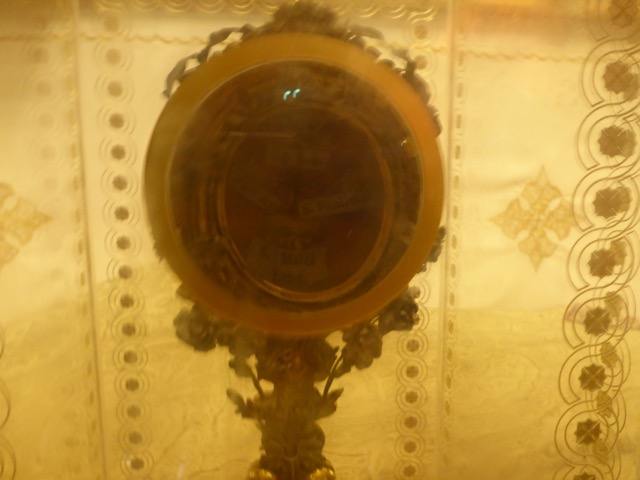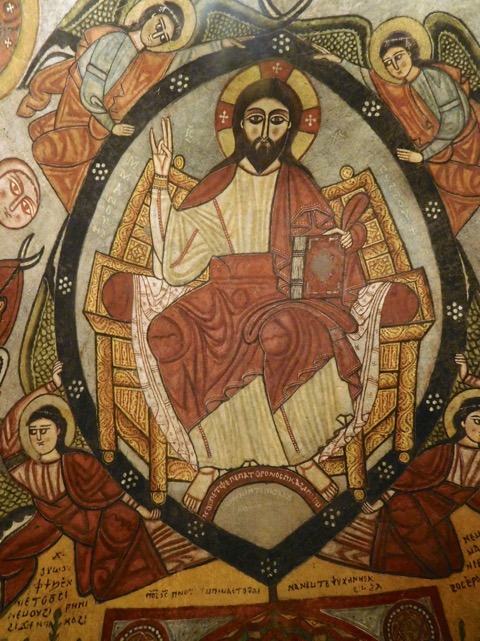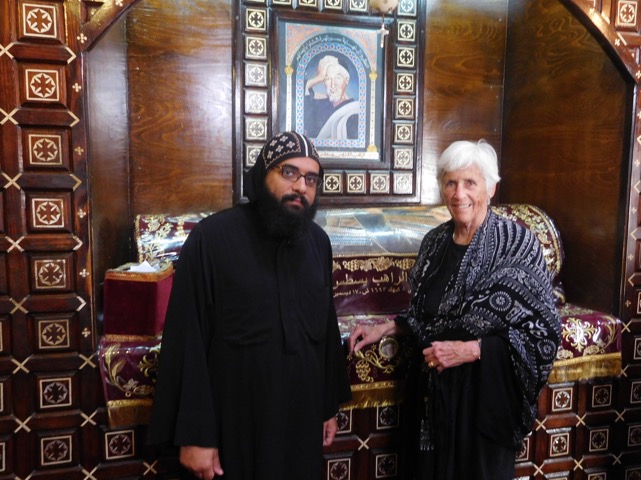Egypt has been historically a country of pharaohs, patriarchs, Old Testament fathers, New Testament saints and believe it or not, in the Coptic Orthodox Church, the presider is also considered a Pope. In fact, talk to a Coptic Orthodox member and he’ll argue that the true Christian church was the Orthodox one, not the Catholic, since it was seeded in the Old Testament long before the arrival of Christ, although St. Mark is their patron saint. I was curious having learned so much about St. Mark’s gospel through Mitzy Minor. And to walk in the door of this magnificent churches in Cairo, as gigantic as a basilica, with super-sized mosaics of God the Father and Jesus on the wall, floor to ceiling behind the altar – of course under repair and construction when I was there. Beneath the main altar, in a small chapel on the bottom floor lie the remains of St. Mark in a tomb about the size of a motorcycle box, with a red velvet cover, a space, a spot, where believers come to worship and pray for his intersession before God.
We had arrived at St. Anthony’s Monastery in the desert, the oldest Monastery in the world, having driven through rough country, the usual hot breezy desert colored like coffee with too much milk and seeing nothing living until we crossed through the gate into the monastery grounds. The buildings resembled what one sees in New Mexico. Tall thick walls and few windows to let the light in. Like every adventure in Egypt, it took about 3 hours to reach these very distant retreats,with regular security check-points, until we arrived first at St. Anthony’s then aiming toward the Red Sea, another hour to the Monastery founded by St. Paul (not Paul of Taurus but the Hermit Paul) before returning along the coast back to Cairo. St. Paul.who sported a long beard, lived on bread and water, bread brought by a raven, water from an well under ground. When Paul died, two lions came to watch them bury him but didn’t attack. The monastery of St. Paul was larger, more tourist buses, but not as accessible as St Anthony’s. The monk who gave us the tour only hit the high spots, like the water source, the grinding house where bread was made, which most monks lived on in the early days. Very little grows in this distant soil-less place.
Groves of Coptic Orthodox Christians draw a pilgrimage into the desert monasteries just to touch or kiss the hands of the monks, venerated because the monks touch the body and blood of Christ at the Eucharist, and therefore their hands are holy, healing instruments, sin pardoners, hope givers. It’s such a quick exchange, usually a family – each one touches the hand of the monk before he quickly pulls it away like that hand game kids play -as if to prevent it from happening, but not fast enough to succeed. But the power in that, the recognition that the hands that serve the body and blood of Christ, tweaked my soul because those of us who are ordained priests and bishops, also serve the body and blood of Christ with our hands, the same hands that pardon and absolve and bless, therefore clergy should be so cautious about what we do with those same hands in every day life, in other words, nothing that could desecrate the holiness of the Eucharist we bless and serve in all kinds of situations. As we strolled with our monk guide named George, he was besieged constantly by kids, parents, old folks and crippled ones, just to touch his hands.
We had arrived at St. Anthony’s Monastery in the desert, the oldest Monastery in the world, having driven through rough country, the usual hot breezy desert colored like coffee with too much milk and seeing nothing living until we crossed through the gate into the monastery grounds. The buildings resembled what one sees in New Mexico. Tall thick walls and few windows to let the light in. Like every adventure in Egypt, it took about 3 hours to reach these very distant retreats,with regular security check-points, until we arrived first at St. Anthony’s then aiming toward the Red Sea, another hour to the Monastery founded by St. Paul (not Paul of Taurus but the Hermit Paul) before returning along the coast back to Cairo. The monastery of St. Paul was larger, more tourist buses, but not as accessible. The monk who gave us the tour only hit the high spots, like the water source, the grinding house where bread was made, which most monks lived on in the early days. Very little grows in this distant soil-less place.
St. Anthony, considered the father of monasticism, was born 251 AD, to rich parents who loved the church and supported the poor. His parents died young and he was left to administer land holdings of the family and to care for his sister. Once he entered the church as a deacon was reading Matthew 19:21 – “If you want to be perfect, go sell what you have and give to the poor and you will have treasure in heaven, and come follow me.” He immediately relinquished his inheritance and family ties and took on strict ascetic habits and a life of prayer constantly combating a stubborn Satan and to combat the demon of boredom and inertia that attacked him at noon.He even spent 20 years in a burial vault with only a single friend bringing him bits of bread now and then. To get away from the fame that was stirring, he went far away to the inner desert near a spring of water and a few date palm trees where the monastery is today and it is worth a visit. Continuing to deal with all the above, he lived in good health on bread and water and probably dates until he reached 105 years. Only two of his disciple monks know where he is buried. In the very large monastery are rooms for the monks and also for pilgrims as well as bus loads of visitors, mostly Egyptians.
The monks act as guides and we were given a blessing with George, a very gentle and patient young man with the black beard the monks sport, who spoke English and had the keys to get us in to most places others aren’t allowed. The chapels ceilings and walls are covered with treasured frescoes and one special one we were able to visit and George asked if I wanted to pray at the Coptic Door on the other side of which their Eucharist is celebrated. Normally, it is not opened for visitor or congregant or to see the other side, except during the mass, so I felt humbled and really didn’t want to invade with my eyes the other side if it was a violation of anything, but he encouraged me to do so, and left me for a few minutes to pray for my own. He gave me a wooden cross (I’d call it a walking cross) because Coptic monks and priests carry these style crosses with them to bless the faithful or unfaithful with a touch. In return, I gave him the creative and special prayer beads made by our Suzanne Hensley.









